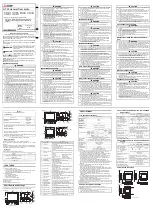
NORA-W36 series - System integration manual
UBX-22021120 - R01
Design-in
Page 20 of 48
C1-Public
3.3
Data communication interfaces
3.3.1
Asynchronous serial interface (UART) design
The layout of the UART bus should be implemented so that noise injection and cross talk are avoided.
It is advisable to use the hardware flow control with RTS/CTS to prevent temporary UART buffer
overrun.
The flow control signals
RTS/CTS
are active low. Consequently, 0 (ON state = low level) allows the
UART to transmit.
•
CTS
is an input to the NORA-W36 module. If the host sets this input to 0 (ON state = low level) the
module can transmit.
•
RTS
is an output from the NORA-W36 module. The module sets the output to 0 (ON state = low
level) when it is ready to receive transmission.
3.4
General high-speed layout guidelines
These guidelines describe the best schematic and layout practices for integrating the module on a
host PCB. Designers should prioritize the layout of higher speed buses. Low frequency signals, other
than those with high-impedance traces, are generally not layout critical.
⚠
Low frequency signals with high-impedance traces (such as signals driven by weak pull resistors)
may be affected by crosstalk. For these high-impedance traces, a supplementary isolation of 4*W
from other buses is recommended.
3.4.1
Considerations for schematic design and PCB floor-planning
•
Verify which signal bus requires termination and add series resistor terminations to the
schematics.
•
Carefully consider the placement of the module with respect to antenna position.
•
Verify with PCB manufacturer allowable stack-ups and controlled impedance dimensioning.
•
Verify that the power supply design and power sequence are compliant with the specification of
NORA-W36 series module.
3.4.2
Component placement
•
Accessory parts like bypass capacitors should be placed as close as possible to the module to
improve filtering capability, prioritizing the placement of the smallest size capacitor close to
module pads.
•
Do
n’
t place components close to the antenna area. Follow the recommendations of the antenna
manufacturer to determine distance of the antenna in relation to other parts of the system.
Designers should also maximize the distance of the antenna to high-frequency busses, like DDRs
and related components. Alternatively, consider an optional metal shield to reduce interference
that might otherwise be picked up by the antenna and subsequently reduce module sensitivity.
•
An optimized module placement allows better RF performance. For more information about the
module placement and other antenna considerations, see also
















































